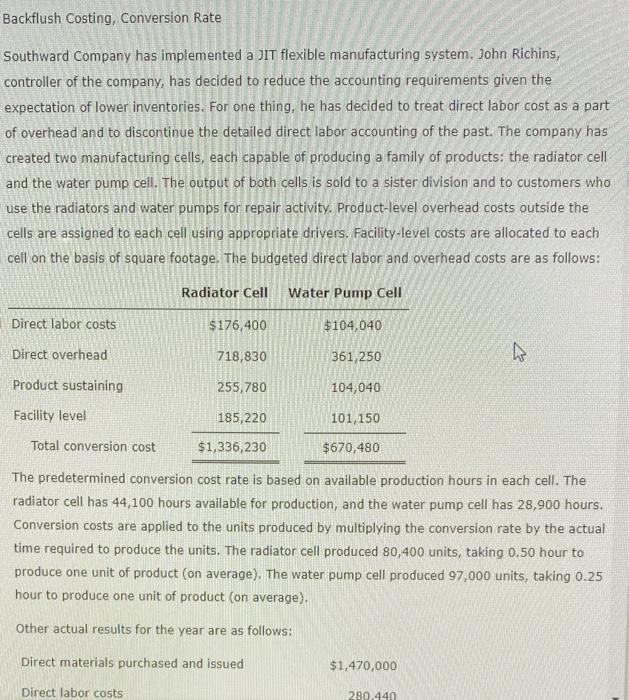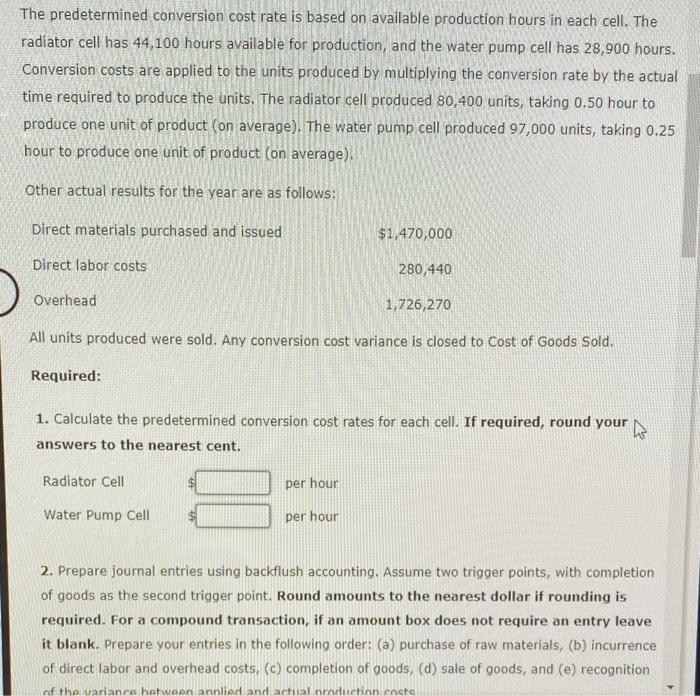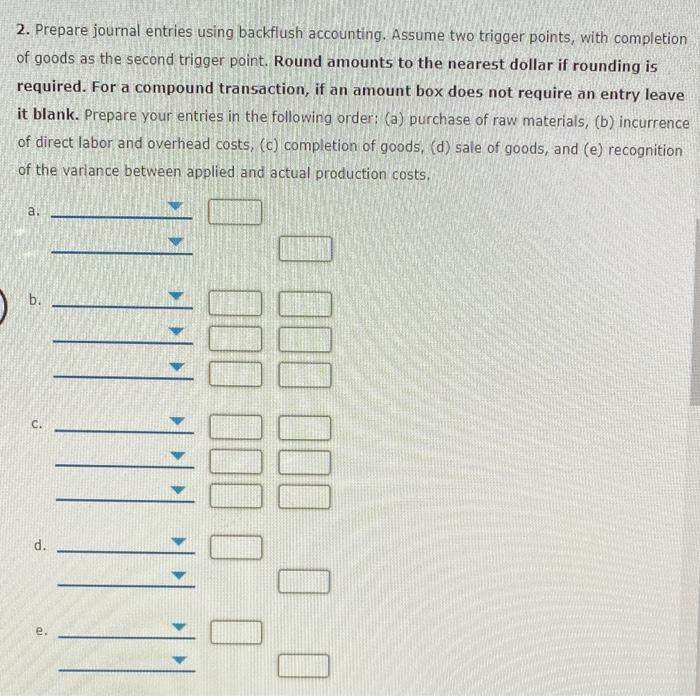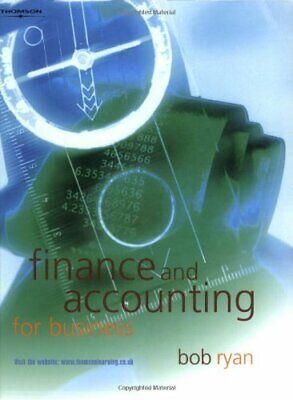Backflush Costing, Conversion Rate Southward Company has implemented a JIT flexible manufacturing system. John Richins, controller of the company, has decided to reduce the accounting requirements given the expectation of lower inventories. For one thing, he has decided to treat direct labor cost as a part of overhead and to discontinue the detailed direct labor accounting of the past. The company has created two manufacturing cells, each capable of producing a family of products: the radiator cell and the water pump cell. The output of both cells is sold to a sister division and to customers who use the radiators and water pumps for repair activity. Product-level overhead costs outside the cells are assigned to each cell using appropriate drivers. Facility-level costs are allocated to each cell on the basis of square footage. The budgeted direct labor and overhead costs are as follows: Radiator Cell Water Pump Cell Direct labor costs $176,400 $104,040 2 Direct overhead 718,830 361,250 Product sustaining 255,780 104,040 Facility level 185,220 101,150 Total conversion cost $1,336,230 $670,480 The predetermined conversion cost rate is based on available production hours in each cell. The radiator cell has 44,100 hours available for production, and the water pump cell has 28,900 hours. Conversion costs are applied to the units produced by multiplying the conversion rate by the actual time required to produce the units. The radiator cell produced 80,400 units, taking 0.50 hour to produce one unit of product (on average). The water pump cell produced 97,000 units, taking 0.25 hour to produce one unit of product (on average). Other actual results for the year are as follows: Direct materials purchased and issued $1,470,000 Direct labor costs 280.440 The predetermined conversion cost rate is based on available production hours in each cell. The radiator cell has 44,100 hours available for production, and the water pump cell has 28,900 hours. Conversion costs are applied to the units produced by multiplying the conversion rate by the actual time required to produce the units. The radiator cell produced 80,400 units, taking 0.50 hour to produce one unit of product (on average). The water pump cell produced 97,000 units, taking 0.25 hour to produce one unit of product (on average). Other actual results for the year are as follows: Direct materials purchased and issued $1,470,000 Direct labor costs 280,440 Overhead 1,726,270 All units produced were sold. Any conversion cost variance is closed to Cost of Goods Sold. Required: 1. Calculate the predetermined conversion cost rates for each cell. If required, round your answers to the nearest cent. Radiator Cell per hour Water Pump Cell per hour 2. Prepare journal entries using backflush accounting. Assume two trigger points, with completion of goods as the second trigger point. Round amounts to the nearest dollar if rounding is required. For a compound transaction, if an amount box does not require an entry leave it blank. Prepare your entries in the following order: (a) purchase of raw materials, (b) incurrence of direct labor and overhead costs, (c) completion of goods, (d) sale of goods, and (e) recognition of the varianra hetueen annlied and actual nraduction coste 2. Prepare journal entries using backflush accounting, Assume two trigger points, with completion of goods as the second trigger point. Round amounts to the nearest dollar if rounding is required. For a compound transaction, if an amount box does not require an entry leave it blank. Prepare your entries in the following order: (a) purchase of raw materials, (b) incurrence of direct labor and overhead costs, (c) completion of goods, (d) sale of goods, and (e) recognition of the variance between applied and actual production costs, a. b. C. 1111 110 lll lll d. e. 3. Repeat Requirement 2, assuming that the second trigger point is the sale of the goods. Round amounts to the nearest dollar if rounding is required. For a compound transaction, if an amount box does not require an entry leave it blank. Prepare your entries in the following order: (a) purchase of raw materials, (b) incurrence of direct labor and overhead costs, (c) completion and sale of goods, and (d) recognition of the variance between applied and actual production costs. b. C. 110 III I bil 110 0 d. 4. Why is there no need to have a work-in-process inventory account? 5. Two variants of backflush costing were presented in which each used two trigger points, with the second trigger point differing. Suppose that the only trigger point for recognizing manufacturing costs occurs when the goods are sold. How would the entries be listed here? Round amounts to the nearest dollar if rounding is required. For a compound transaction, if an amount box does not require an entry leave it blank. Prepare your entries in the following order: (a) incurrence of direct labor and overhead costs, (b) completion and sale of goods, and (c) recognition of the variance between applied and actual production costs. a 111 110 110 110 . IN When would this backflush variant be considered appropriate











